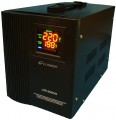Power
The maximum active load power allowed for this model.
Active power is the power that in AC appliances is spent on useful work or on heat generation. In addition to it, such devices also consume reactive power — it goes to the operation of specific components, primarily capacitors and inductors. Apparent power, denoted in volt-amperes (kilovolt-amperes), is the sum of active and reactive, see below about it. Here we note that in simple everyday situations, there is enough data on active power indicated in watts for calculations. In particular, it is this parameter that is considered the key when choosing stabilizers
for washing machines and
dishwashers : in the first case, power from 2 to 5 kW is considered optimal, in the second — from 1.8 to 2.5 kW.
Anyway, the total active power of the connected load should not exceed the figures indicated in the characteristics of the stabilizer. For a full guarantee, it's ok to take a certain margin, but this margin should not be too large — an increase in the allowable power significantly affects the dimensions, weight and price of the device. Also note that there are formulas that allow you to convert the active power consumption into total power, taking into account the type of connected electrical appliance; these formulas can be found in special sources.
Input voltage range
The voltage range at the input of the stabilizer, at which it is able to operate in normal mode and supply a constant voltage of 230 or 400 V to the load (depending on the number of phases, see above). The wider this range — the more versatile the device, the more serious power surges it can extinguish without going beyond the standard operating parameters. However, note that this parameter is not the only, and not even far from the main indicator of the quality of work: a lot also depends on the accuracy of the output voltage and the response speed (see both points below).
Also note that some models may have several modes of operation (for example, with 230 V, 230 V or 240 V output). In this case, the characteristics indicate the "general" input voltage range, from the smallest minimum to the largest maximum; the actual ranges for each particular mode will vary.
In addition, there are stabilizers that can operate outside the nominal input voltage range: with a slight deviation beyond its limits, the device provides relatively safe output indicators (also with some deviations from the nominal 230 or 400 V), but if the drop or rise becomes critical, it works appropriate protection (see below).
Output voltage accuracy (±)
The largest deviation from the nominal output voltage (230 V or 400 V, depending on the number of phases), which the regulator allows when operating in the normal input voltage range (see above). The smaller this deviation, the more efficiently the device works, the more accurately it adapts to “changes in the situation” and the less voltage fluctuations the connected load is exposed to.
When choosing for this parameter, it is worth considering first of all how demanding the connected devices are for voltage stability. On the one hand, high stability is good for any device, on the other hand, it usually means a high price. Accordingly, it usually does not make sense to buy an advanced stabilizer for an unpretentious load like light bulbs and heaters, but for sensitive devices like audio systems or computers, it can be very useful.
Response time
The rate at which the regulator responds to changes in input voltage. It is determined by the time that passes from the moment of a power surge until the moment when the device fully adjusts to the new parameters and the output current corresponds to the standard 230 or 400 V (depending on the number of phases, see above). Accordingly, the shorter the response time, the better the stabilizer works, the lower the likelihood that a power surge will significantly affect the connected equipment. On the other hand, not all types of electrical appliances are sensitive to speed — for some, smooth adjustment or voltage accuracy is more important (see above); and the high speed itself can significantly affect the price of the device. Therefore, when choosing by this parameter, it makes sense to consider which devices are planned to be connected through the stabilizer.
Efficiency
The efficiency of the stabilizer is the ratio, expressed as a percentage, between the amount of electricity at the output of the device to the amount of energy at the input. In other words, efficiency describes how much of the energy received from the network the device transfers to the connected load without loss. And losses during operation will be inevitable — firstly, not a single transformer is perfect, and secondly, the control circuits of the stabilizer also require a certain amount of energy to work. At the same time, all these costs are quite small, and even in relatively simple modern models, the efficiency can reach 97-98%.

